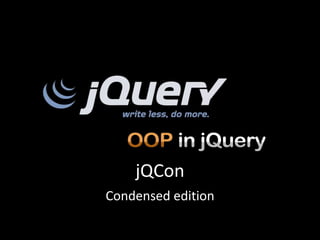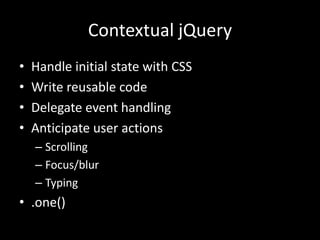jQuery Conf 2012
- 2. Review âĒ Selector performance â ID â Tag name â Name, Class âĒ Use CSS classes to control state âĒ Specificity helps â Ex: $(âdiv.ui-contentâ); instead of $(â.ui-contentâ)
- 3. Performance Visibility: Business: â Install Firebug & Yslow â Performance is important for â Know what is slowing down the product your page loads â Performance can be expensive â Optimize intelligently - weigh the LOE and the utility gained Interactivity: â Performance is most important â Profile your $.ready to sites that get millions of hits â Minimize initialization on page load Tips: â Low hanging fruit first Responsiveness: â Google Analytics to record data â throttle/debounce events about your loads â 8-bit PNG's with alpha
- 4. Contextual jQuery âĒ Handle initial state with CSS âĒ Write reusable code âĒ Delegate event handling âĒ Anticipate user actions â Scrolling â Focus/blur â Typing âĒ .one()
- 5. Unit Testing âĒ qUnit âĒ qUnit âĒ qUnit âĒ And qUnit
- 6. Grunt âĒ Build tool for JS âĒ Included tasks â Creates scaffolding â Lint (JSHint) â Unit testing (qUnit) â Concat/Minify (UglifyJS)
- 7. PhantomJS âĒ Headless WebKit â Like the horseman? Why is this cool? âĒ Grunt + PhantomJS + qUnit = ?
- 9. Recap of Steps âĒ brew install node âĒ brew install phantomjs âĒ npm install -g grunt âĒ grunt -help (Optional) âĒ grunt init (Optional) âĒ grunt init:jquery âĒ grunt qunit
- 10. Tools âĒ YSlow, PageSpeed âĒ JavaScript Errors Notifier Chrome Extension âĒ iWebInspector âĒ JSHint (for vim)
- 11. Resources âĒ Wiki pages â jQuery Conf 2012 â Best Practices: jQuery â Web Dev Quirks âĒ Read more â Introducing Grunt â jQuery Plugins w/ Grunt & qUnit â https://github.com/cowboy/grunt â qUnit Intro
Editor's Notes
- #2: Explain the format, # of attendees, the general vibeBreakout sessions
- #3: Explain why the selector performance orderExplain why the specificity helps
- #4: If it takes you more than a day to implement 1 increase in performance, it is probably not worthwhile. Gauge the effort with the importanceYslow - Initialization after page loadProfilingThrottle/debounce
- #5: Initial state with CSS goes against jQuery Mobile, that may mean a change for UIE.Delegating event handling - CPU saved on initial binding: 1 container vs multiple child elementsExamples: - Scrolling â FB Like/audio/images - Focus/blur â form validation/autocomplete - Typing â load next pages in a multi-step process
- #6: It seems that the jQuery community has chosen a unit testing framework unanimously.A unit testing framework is only a unit testing framework.qUnit has thrived because of Grunt & PhantomJS
- #7: This was created by Ben Alman of Bocoup.He created this to solve many problems, but the biggest problem he solved was eliminating the configuration/setup phase of a project to use Linting, unit testing, and Concat/Minify.
- #8: PhantomJS is cool because it runs like a phantom.Typical qUnit opens an actual browser, this runs on the command line.
- #11: JSHint has plugins for other editors as well.
- #12: šÝšÝßĢs and notes from the conferencecan be found in the wikiBest PracticesWeb dev quirks â this may or may not be useful to you










